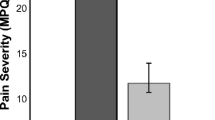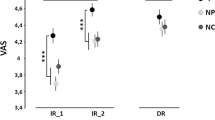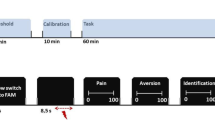Abstract
Although body awareness and pain perception are considered to be parts of the interoceptive system, the relationship between them is unclear. This study examines the association between body awareness and pain habituation, hypothesizing that this association is moderated by pain catastrophizing and mindfulness. Sixty subjects received a mildly aversive electrical stimulus for 60 s, during which they were requested to rate the amount of perceived pain. Complete habituation was indicated by abolition of pain sensation; partial habituation was indicated by a decrease in pain sensation. Individuals who demonstrated complete habituation had lower levels of pain catastrophizing and lower levels of mindfulness. As hypothesized, the association between body awareness and pain habituation was moderated by pain catastrophizing: Among low pain catastrophizers, the higher the body awareness, the stronger the tendency to exhibit complete habituation. Among high pain catastrophizers, the higher the body awareness, the greater the likelihood to present partial habituation.


Similar content being viewed by others
References
Barnes, P. M., Bloom, B., Nahin, R. L., & Statistics NCfH. (2008). Complementary and alternative medicine use among adults and children: United States, 2007. US Department of Health and Human Services, Centers for Disease Control and Prevention, National Center for Health Statistics: Hyattsville, MD.
Andersen, R. (2006). Body Intelligence Scale: Defining and measuring the intelligence of the body. Humanistic Psychologist, 34, 357–367.
Arendt-Nielsen, L., & Yarnitsky, D. (2009). Experimental and clinical applications of quantitative sensory testing applied to skin, muscles and viscera. Journal of Pain, 10, 556–572.
Arntz, A., Dreessen, L., & Merckelbach, H. (1991). Attention, not anxiety, influences pain. Behaviour Research and Therapy, 29, 41–50.
Baer, R. A., Smith, G. T., Hopkins, J., Krietemeyer, J., & Toney, L. (2006). Using self-report assessment methods to explore facets of mindfulness. Assessment, 13, 27–45.
Bingel, U., Schoell, E., Herken, W., Büchel, C., & May, A. (2007). Habituation to painful stimulation involves the antinociceptive system. Pain, 131, 21–30.
Breivik, H., Collett, B., Ventafridda, V., Cohen, R., & Gallacher, D. (2006). Survey of chronic pain in Europe: Prevalence, impact on daily life, and treatment. European Journal of Pain, 10, 287.
Brooks, J. C., Nurmikko, T. J., Bimson, W. E., Singh, K. D., & Roberts, N. (2002). fMRI of thermal pain: Effects of stimulus laterality and attention. Neuroimage, 15, 293–301.
Brown, C. A., & Jones, A. K. (2010). Meditation experience predicts less negative appraisal of pain: Electrophysiological evidence for the involvement of anticipatory neural responses. Pain, 150, 428–438.
Brown, K. W., & Ryan, R. M. (2003). The benefits of being present: mindfulness and its role in psychological well-being. Journal of Personality and Social Psychology, 84, 822–848.
Brown, K. W., Ryan, R. M., & Creswell, J. D. (2007). Mindfulness: Theoretical foundations and evidence for its salutary effects. Psychological Inquiry, 18, 211–237.
Burns, J. W., Kubilus, A., Bruehl, S., Harden, R. N., & Lofland, K. (2003). Do changes in cognitive factors influence outcome following multidisciplinary treatment for chronic pain? A cross-lagged panel analysis. Journal of Consulting and Clinical Psychology, 71, 81–91. doi:10.1037/0022-006X.71.1.81
Carmody, J., & Baer, R. A. (2008). Relationships between mindfulness practice and levels of mindfulness, medical and psychological symptoms and well-being in a mindfulness-based stress reduction program. Journal of Behavioral Medicine, 31, 23–33.
Cathcart, S., Petkov, J., & Pritchard, D. (2008). Effects of induced stress on experimental pain sensitivity in chronic tension-type headache sufferers. European Journal of Neurology, 15, 552–558.
Coghill, R. C., Mayer, D. J., & Price, D. D. (1993). Wide dynamic range but not nociceptive-specific neurons encode multidimensional features of prolonged repetitive heat pain. Journal of Neurophysiology, 69, 703–716.
Coghill, R. C., Sang, C. N., Maisog, M. J., & Iadarola, M. J. (1999). Pain intensity processing within the human brain: A bilateral, distributed mechanism. Journal of Neurophysiology, 82, 1934–1942.
Condes-Lara, M., Calvo, J. M., & Fernandez-Guardiola, A. (1981). Habituation to bearable experimental pain elicited by tooth pulp electrical stimulation. Pain, 11, 185–200.
Craig, A. D. (2002). How do you feel? Interoception: the sense of the physiological condition of the body. Nature Reviews Neuroscience, 3, 655–666.
Craig, A. D. (2003a). Interoception: The sense of the physiological condition of the body. Current Opinions in Neurobiology, 13, 500–505.
Craig, A. D. (2003b). A new view of pain as a homeostatic emotion. Trends in Neurosciences, 26, 303–307.
Craig, A. D. (2004). Human feelings: Why are some more aware than others? Trends in Cognitive Sciences, 8, 239–241. doi:10.1016/j.tics.2004.04.004
Craig, A. D. (2010). The sentient self. Brain Structure and Function, 214, 563–577. doi:10.1007/s00429-010-0248-y
Crettaz, B., Marziniak, M., Willeke, P., Young, P., Hellhammer, D., Stumpf, A., & Burgmer, M. (2013). Stress-induced allodynia: Evidence of increased pain sensitivity in healthy humans and patients with chronic pain after experimentally induced psychosocial stress. PLoS One, 8, e69460.
Critchley, H. D., Wiens, S., Rotshtein, P., Ohman, A., & Dolan, R. J. (2004). Neural systems supporting interoceptive awareness. Nature Neuroscience, 7, 189–195. doi:10.1038/nn1176
Crombez, G., Eccleston, C., Baeyens, F., & Eelen, P. (1998). When somatic information threatens, catastrophic thinking enhances attentional interference. Pain, 75, 187–198.
Davis, K. D. (2000). The neural circuitry of pain as explored with functional MRI. Neurological Research, 22, 313–317.
Defrin, R., Ginzburg, K., Mikulincer, M., & Solomon, Z. (2014). The long-term impact of tissue injury on pain processing and modulation: A study on ex-prisoners of war who underwent torture. European Journal of Pain, 18, 548–558.
Defrin, R., Riabinin, M., Feingold, Y., Schreiber, S., & Pick, C. G. (2015). Deficient pain modulatory systems in patients with mild traumatic brain and chronic oost-traumatic headache: Implications for its mechanism. Journal of Neurotrauma, 32, 28–37.
Domschke, K., Stevens, S., Pfleiderer, B., & Gerlach, A. L. (2010). Interoceptive sensitivity in anxiety and anxiety disorders: An overview and integration of neurobiological findings. Clinical Psychology Review, 30, 1–11. doi:10.1016/j.cpr.2009.08.008
Edwards, R. R., & Fillingim, R. B. (2001). Effects of age on temporal summation and habituation of thermal pain: Clinical relevance in healthy older and younger adults. Journal of Pain, 2, 307–317.
Edwards, R. R., Smith, M. T., Stonerock, G., & Haythornthwaite, J. A. (2006). Pain-related catastrophizing in healthy women is associated with greater temporal summation of and reduced habituation to thermal pain. Clinical Journal of Pain, 22, 730–737.
Esteve, R. M., & Camacho, L. (2008). Anxiety sensitivity, body vigilance and fear of pain. Behaviour Research and Therapy, 46, 715–727.
Geva, N., Pruessner, J., & Defrin, R. (2014). Acute psychosocial stress reduces pain modulation capabilities in healthy men. Pain, 155, 2418–2425.
Ginzburg, K., Tsur, N., Barak-Nahum, A., & Defrin, R. (2014). Body awareness: Differentiating between sensitivity to and monitoring of bodily signals. Journal of Behavioral Medicine, 37, 564–575. doi:10.1007/s10865-013-9514-9
Granot, M., Khoury, R., Berger, G., Krivoy, N., Braun, E., Aronson, D., & Azzam, Z. S. (2007). Clinical and experimental pain perception is attenuated in patients with painless myocardial infarction. Pain, 133, 120–127.
Grant, J. A., & Rainville, P. (2009). Pain sensitivity and analgesic effects of mindful states in Zen meditators: A cross-sectional study. Psychosomatic Medicine, 71, 106–114.
Haase, L., Cerf-Ducastel, B., & Murphy, C. (2009). Cortical activation in response to pure taste stimuli during the physiological states of hunger and satiety. Neuroimage, 44, 1008–10021.
Haugstad, G. K., Haugstad, T. S., Kirste, U. M., Leganger, S., Wojniusz, S., Klemmetsen, I., & Malt, U. F. (2006). Posture, movement patterns, and body awareness in women with chronic pelvic pain. Journal of Psychosomatic Research, 61, 637–644. doi:10.1016/j.jpsychores.2006.05.003
Hayes, A. F. (2012). PROCESS: A versatile computational tool for observed variable mediation, moderation, and conditional process modeling [White paper]. Retrieved from http://www.afhayes.com/public/process2012.pdf.
Hayes, A. F., & Matthes, J. (2009). Computational procedures for probing interactions in OLS and logisticregression: SPSS and SAS implementations. Behavior research methods, 41(3), 924–936.
Hopper, J. W., Frewen, P. A., van der Kolk, B. A., & Lanius, R. A. (2007). Neural correlates of reexperiencing, avoidance, and dissociation in PTSD: Symptom dimensions and emotion dysregulation in responses to script-driven trauma imagery. Journal of Traumatic Stress, 20, 713–725.
Hsu, D. T., Lombardo, K. A., Bakshi, V. P., Balachandran, J. S., Roseboom, P. H., & Kalin, N. H. (2001). Acute stress-induced increases in thalamic CRH mRNA are blocked by repeated stress exposure. Brain Research, 915, 18–24.
Johnston, N. E., Atlas, L. Y., & Wager, T. D. (2012). Opposing effects of expectancy and somatic focus on pain. PLoS One, 7, e38854–e38854.
Kadota, Y., Cooper, G., Burton, A. R., Lemon, J., Schall, U., Lloyd, A., & Vollmer-Conna, U. (2010). Autonomic hyper-vigilance in post-infective fatigue syndrome. Biological Psychology, 85, 97–103. doi:10.1016/j.biopsycho.2010.05.009
King, C. D., Goodin, B., Kindler, L. L., Caudle, R. M., Edwards, R. R., Gravenstein, N., et al. (2013). Reduction of conditioned pain modulation in humans by naltrexone: An exploratory study of the effects of pain catastrophizing. Journal of Behavioral Medicine, 36, 315–327. doi:10.1007/s10865-012-9424-2
Kinomuraa, S., Kawashima, R., Yamadaa, R., Ono, S., Itoh, M., Yoshiokaa, S., et al. (1994). Functional anatomy of taste perception in the human brain studied with positron emission tomography. Brain Research, 659, 263–266.
Kleinböhl, D., Trojan, J., Konrad, C., & Hölzl, R. (2006). Sensitization and habituation of AMH and C-fiber related percepts of repetitive radiant heat stimulation. Clinical Neurophysiology, 117, 118–130.
Koroboki, E., Zakopoulos, N., Manios, E., Rotas, V., Papadimitriou, G., & Papageorgiou, C. (2010). Interoceptive awareness in essential hypertension. International Journal of Psychophysiology, 78, 158–162. doi:10.1016/j.ijpsycho.2010.07.003
Koyama, Y., Koyama, T., Kroncke, A. P., & Coghill, R. C. (2004). Effects of stimulus duration on heat induced pain: the relationship between real-time and post-stimulus pain ratings. Pain, 107, 256–266.
Lee, J. E., Watson, D., & Frey Law, L. A. (2010). Lower-order pain-related constructs are more predictive of cold pressor pain ratings than higher-order personality traits. Journal of Pain, 11, 681–691. doi:10.1016/j.jpain.2009.10.013
Lowenstein, L., Kenton, K., Mueller, E. R., Brubaker, L., Heneghan, M., Senka, J., & Fitzgerald, M. P. (2009). Patients with painful bladder syndrome have altered response to thermal stimuli and catastrophic reaction to painful experiences. Neurourology and Urodynamics, 28, 400–404. doi:10.1002/nau.20676
Lutz, A., McFarlin, D. R., Perlman, D. M., Salomons, T. V., & Davidson, R. J. (2013). Altered anterior insula activation during anticipation and experience of painful stimuli in expert meditators. Neuroimage, 64, 538–546.
Mehling, W. E., Gopisetty, V., Daubenmier, J., Price, C. J., Hecht, F. M., & Stewart, A. (2009). Body awareness: Construct and self-report measures. PLoS One, 4, e5614. doi:10.1371/journal.pone.0005614
Mehling, W. E., Hamel, K. A., Acree, M., Byl, N., & Hecht, F. M. (2005). Randomized, controlled trial of breath therapy for patients with chronic low-back pain. Alternative Therapies in Health and Medicine, 11, 44–52.
Mehling, W. E., Price, C., Daubenmier, J. J., Acree, M., Bartmess, E., & Stewart, A. (2012). The multidimensional assessment of interoceptive awareness (MAIA). Plos One, 7, e48230–e48230. doi:10.1371/journal.pone.0048230
Miller, L. C., Murphy, R., & Buss, A. H. (1981). Consciousness of body: Private and public. Journal of Personality and Social Psychology, 41, 397–406.
Mogil, J. S., & Bailey, A. L. (2010). Sex and gender differences in pain and analgesia. Progress in Brain Research, 186, 141–157.
Peters, M. L., Schmidt, A. J. M., & Van den Hout, M. A. (1989). Chronic low back pain and the reaction to repeated acute pain stimulation. Pain, 39, 69–76.
Pollatos, O., Füstös, J., & Critchley, H. D. (2012). On the generalised embodiment of pain: how interoceptive sensitivity modulates cutaneous pain perception. Pain, 153, 1680–1686. doi:10.1016/j.pain.2012.04.030
Pollatos, O., Gramann, K., & Schandry, R. (2007a). Neural systems connecting interoceptive awareness and feelings. Human Brain Mapping, 28, 9–18. doi:10.1002/hbm.20258
Pollatos, O., Herbert, B. M., Kaufmann, C., Auer, D. P., & Schandry, R. (2007b). Interoceptive awareness, anxiety and cardiovascular reactivity to isometric exercise. International Journal of Psychophysiology, 65, 167–173. doi:10.1016/j.ijpsycho.2007.03.005
Pollatos, O., Traut-Mattausch, E., Schroeder, H., & Schandry, R. (2007c). Interoceptive awareness mediates the relationship between anxiety and the intensity of unpleasant feelings. Journal of Anxiety Disorders, 21, 931–943. doi:10.1016/j.janxdis.2006.12.004
Prescott, S. A. (1998). Interactions between depression and facilitation within neural networks: Updating the dual-process theory of plasticity. Learning and Memory, 5, 446–466.
Price, C. J., & Thompson, E. A. (2007). Measuring dimensions of body connection: Body awareness and bodily dissociation. Journal of Alternative and Complementary Medicine, 13, 945–953. doi:10.1089/acm.2007.0537
Rainville, P., Duncan, G. H., Price, D. D., Carrier, B., & Bushnell, M. C. (1997). Pain affect encoded in human anterior cingulate but not somatosensory cortex. Science, 277, 968–971.
Reinhardt, T., Kleindienst, N., Treede, R. D., Bohus, M., & Schmahl, C. (2013). Individual modulation of pain sensitivity under stress. Pain Medicine, 14, 676–685.
Rodriguez-Raecke, R., Doganci, B., Breimhorst, M., Stankewitz, A., Büchel, C., Birklein, F., & May, A. (2010). Insular cortex activity is associated with effects of negative expectation on nociceptive long-term habituation. Journal of Neuroscience, 30, 11363–11368.
Shields, S. A., Mallory, M. E., & Simon, A. (1989). The body awareness questionnaire: Reliability and validity. Journal of Personality Assessment, 53, 802–815.
Simmons, W. K., Avery, J. A., Barcalow, J. C., Bodurka, J., Drevets, W. C., & Bellgowan, P. (2013). Keeping the body in mind: Insula functional organization and functional connectivity integrate interoceptive, exteroceptive, and emotional awareness. Human Brain Mapping, 34, 2944–2958. doi:10.1002/hbm.22113
Simons, J. S., Henson, R. N. A., Gilbert, S. J., & Fletcher, P. C. (2008). Separable forms of reality monitoring supported by anterior prefrontal cortex. Journal of Cognitive Neuroscience, 20, 447–457.
Smith, B. W., Tooley, E. M., Montague, E. Q., Robinson, A. E., Cosper, C. J., & Mullins, P. G. (2008). Habituation and sensitization to heat and cold pain in women with fibromyalgia and healthy controls. Pain, 140, 420–428. doi:10.1016/j.pain.2008.09.018
Spoor, S. T., Bekker, M. H. J., Van Heck, G. L., Croon, M. A., & Van Strien, T. (2005). Inner body and outward appearance: The relationships between appearance orientation, eating disorder symptoms, and internal body awareness. Eating Disorders, 13, 479–490. doi:10.1080/10640260500297267
Sullivan, M. J. L., Bishop, S. R., & Pivik, J. (1995). The Pain Catastrophizing Scale: Development and validation. Psychological Assessment, 7, 524–532.
Sullivan, M. J. L., Thorn, B., Haythornthwaite, J. A., Keefe, F., Martin, M., Bradley, L. A., & Lefebvre, J. C. (2001). Theoretical perspectives on the relation between catastrophizing and pain. Clinical Journal of Pain, 17, 52–64.
Tesarz, J., Schuster, A. K., Hartmann, M., Gerhardt, A., & Eich, W. (2012). Pain perception in athletes compared to normally active controls: A systematic review with meta-analysis. Pain, 153, 1253–1262.
Tsakiris, M., Prabhu, G., & Haggard, P. (2006). Having a body versus moving your body: How agency structures body-ownership. Consciousness and Cognition, 15, 423–432. doi:10.1016/j.concog.2005.09.004
Vallis, T. M. (1984). A complete component analysis of stress inoculation for pain tolerance. Cognitive Therapy and Research, 8, 313–329. doi:10.1007/BF01173001
Van der Maas, L. C. C., Köke, A., Pont, M., Bosscher, R. J., Twisk, J. W. R., Janssen, T. W. J., & Peters, M. L. (2015). Improving the multidisciplinary treatment of chronic pain by stimulating body awareness: A cluster-randomized trial. Clinical Journal of Pain, 31, 660–669. doi:10.1097/AJP.0000000000000138
Weissman-Fogel, I., Dror, A., & Defrin, R. (2015). Temporal and spatial aspects of experimental tonic pain: Understanding pain adaptation and intensification. European Journal of Pain, 19, 408–418.
Wilder-Smith, O. H., Schreyer, T., Scheffer, G. J., & Arendt-Nielsen, L. (2010). Patients with chronic pain after abdominal surgery show less preoperative endogenous pain inhibition and more postoperative hyperalgesia: A pilot study. Journal of Pain and Palliative Care Pharmacotherapy, 24, 119–128.
Tsur, N., Defrin, R., & Ginzburg, K. (in preparation). Testing the adaptivity of monitoring and sensitivity to bodily signals: The mediating role of catastrophizing, and the moderating role of mindfulness.
Yarnitsky, D. (2010). Conditioned pain modulation (the diffuse noxious inhibitory control-like effect): Its relevance for acute and chronic pain states. Current Opinion in Anaesthesiology, 23, 611–615.
Zeidan, F., Gordon, N. S., Merchant, J., & Goolkasian, P. (2010). The effects of brief mindfulness meditation training on experimentally induced pain. Journal of Pain, 11, 199–209. doi:10.1016/j.jpain.2009.07.015
Zeidan, F., Martucci, K. T., Kraft, R. A., Gordon, N. S., McHaffie, J. G., & Coghill, R. C. (2011). Brain mechanisms supporting the modulation of pain by mindfulness meditation. Journal of Neuroscience, 31, 5540–5548. doi:10.1523/JNEUROSCI.5791-10.2011
Author information
Authors and Affiliations
Corresponding author
Ethics declarations
Conflict of interest
Karni Ginzburg, Noga Tsur, Carmel Karmin, Tali Speizman, Ricki Tourgeman and Ruth Defrin declare they have no conflict of interest.
Human and animal rights and Informed consent
All procedures followed were in accordance with ethical standards of the responsible committee on human experimentation (institutional and national) and with the Helsinki Declaration of 1975, as revised in 2000. Informed consent was obtained from all patients for being included in the study.
Rights and permissions
About this article
Cite this article
Ginzburg, K., Tsur, N., Karmin, C. et al. Body awareness and pain habituation: the role of orientation towards somatic signals. J Behav Med 38, 876–885 (2015). https://doi.org/10.1007/s10865-015-9676-8
Received:
Accepted:
Published:
Issue Date:
DOI: https://doi.org/10.1007/s10865-015-9676-8




